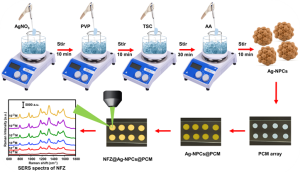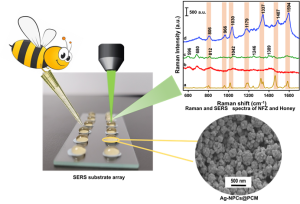- A Novel SERS Substrate to Detect Food Contamination August 6, 2024
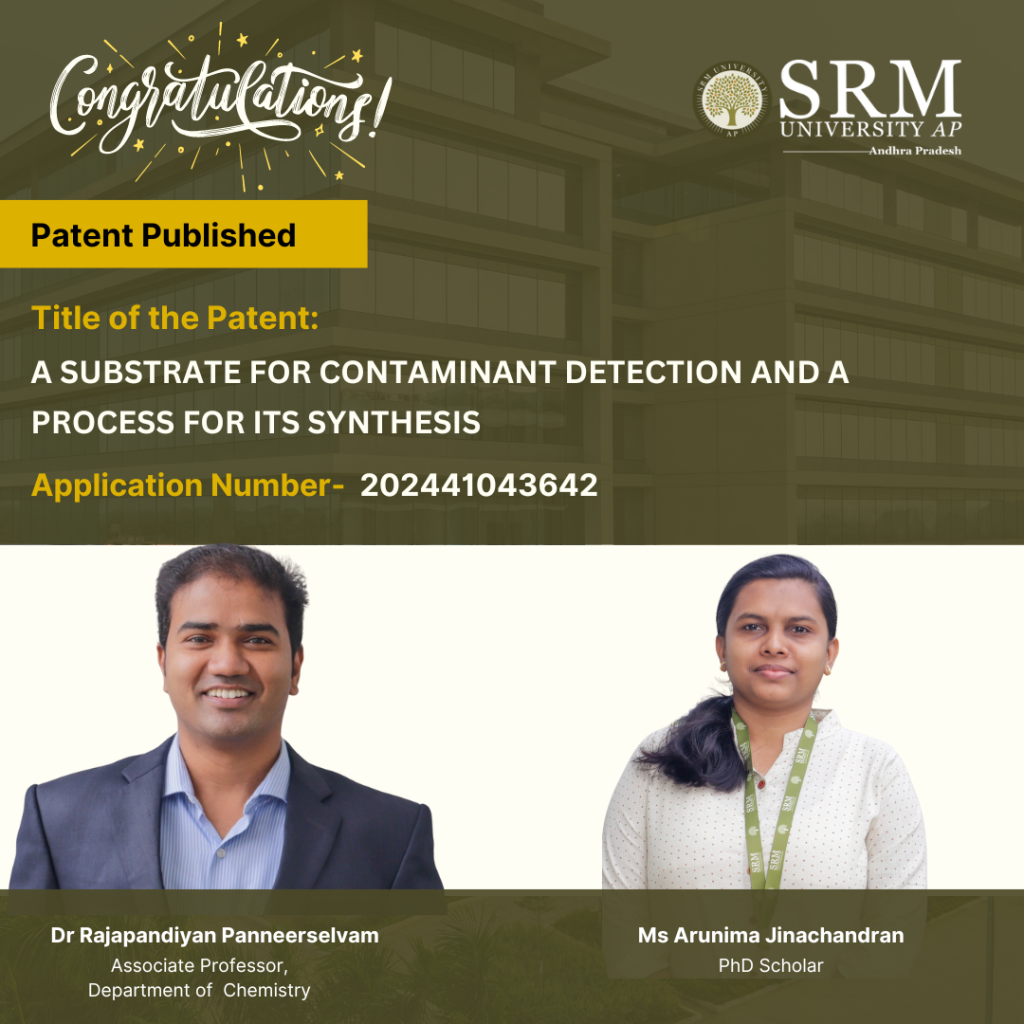
Dr Rajapandiyan P, Associate Professor, Department of Chemistry, and his PhD scholar, Ms Arunima Jinachandran, recently filed and published a patent, “A Substrate for Contaminant Detection and a Process for its Synthesis,” with Application Number: 202441043642 in the Patent Office Journal. The research duo has developed a novel SERS (Surface-Enhanced Raman Spectroscopy) substrate by synthesising silver nanopopcorn and depositing it on a polycarbonate membrane.
This novel substrate demonstrates excellent uniformity, reproducibility, and mechanical stability. It is used for the sensitive detection of toxic antibiotic nitrofurazone on fish surfaces and in honey. This breakthrough could significantly enhance food safety monitoring by providing a reliable and efficient method for detecting harmful substances.
Abstract
Detecting nitrofurazone (NFZ) in aquaculture and livestock is crucial due to its carcinogenic properties. This study presents a flexible polycarbonate membrane (PCM) with three-dimensional silver nanopopcorns (Ag NPCs) for NFZ detection on fish surfaces using surface-enhanced Raman spectroscopy (SERS). The Ag-NPCs/PCM substrate demonstrates a significant Raman signal enhancement (EF = 2.36 × 106) due to hotspots from nanoscale protrusions and crevices. It achieves a low limit of detection (LOD) of 3.7 × 10−9 M, with uniform and reproducible signals (RSD < 8.34%) and retains 70% efficacy after 10 days. The practical detection LODs for NFZ in tap water, honey water, and on fish surfaces are 1.35 × 10−8 M, 5.76 × 10−7 M, and 3.61 × 10−8 M, respectively, demonstrating its effectiveness for various samples. This Ag-NPCs/PCM substrate offers a promising approach for sensitive SERS detection of toxic substances in real-world applications.
Practical Implementation/ Social Implications of the Research
The practical applicability of the proposed Ag-NPCs/PCM SERS substrate is validated by successfully detecting NFZ in various actual samples, such as tap water, honey water, and irregular fish surfaces.
Collaborations – Prof. Tzyy-Jiann Wang – National Taipei University of Technology, Taiwan
Dr Rajapandiyan and Ms Arunima will continue to work towards the development of novel flexible SERS substrates for detecting toxic pollutants in food.
Continue reading → - SRM Group Founder Chancellor Meets CM August 5, 2024
The Deccan Chronicle
Continue reading →

The Hindu
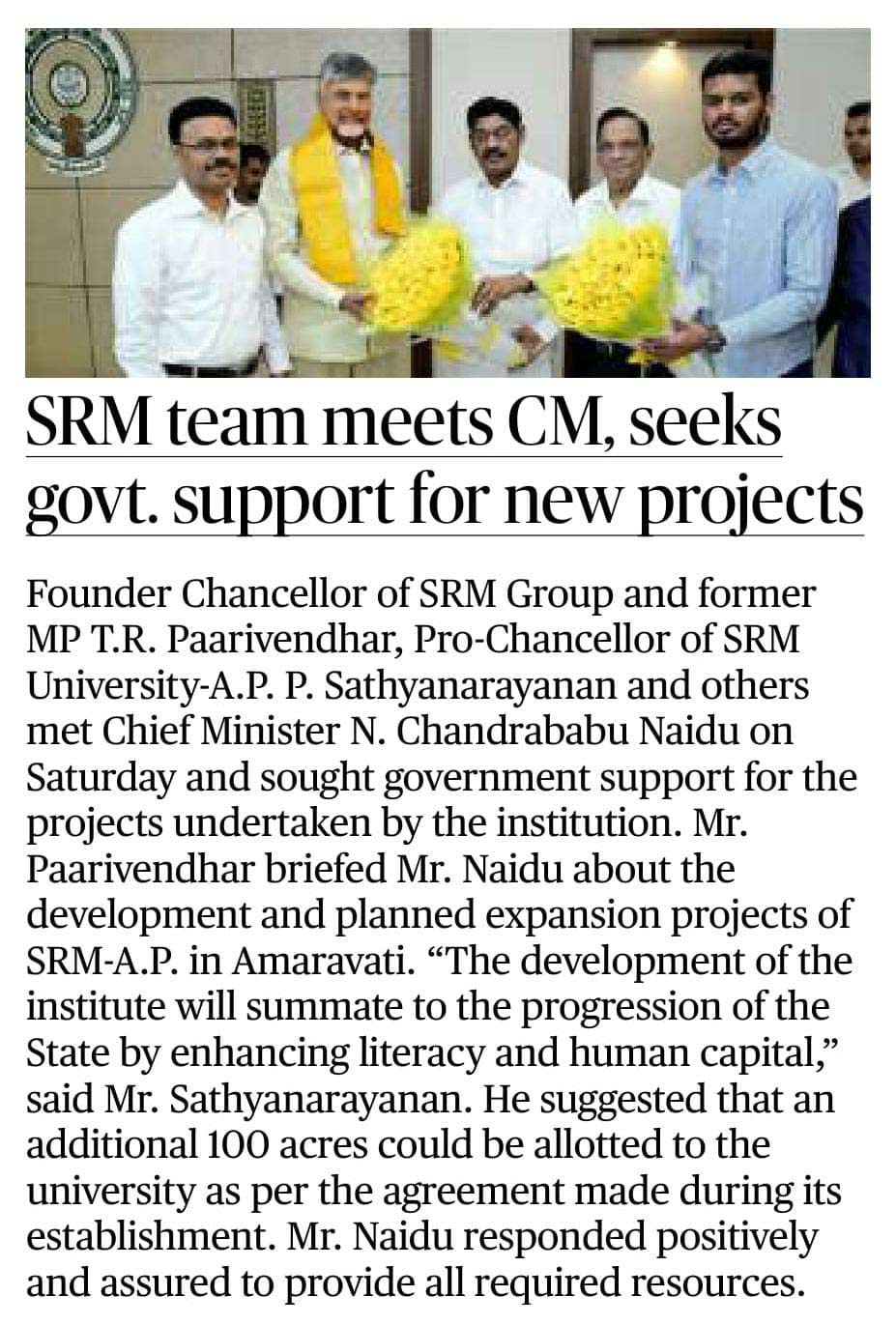
The Hans India

The New Indian Express
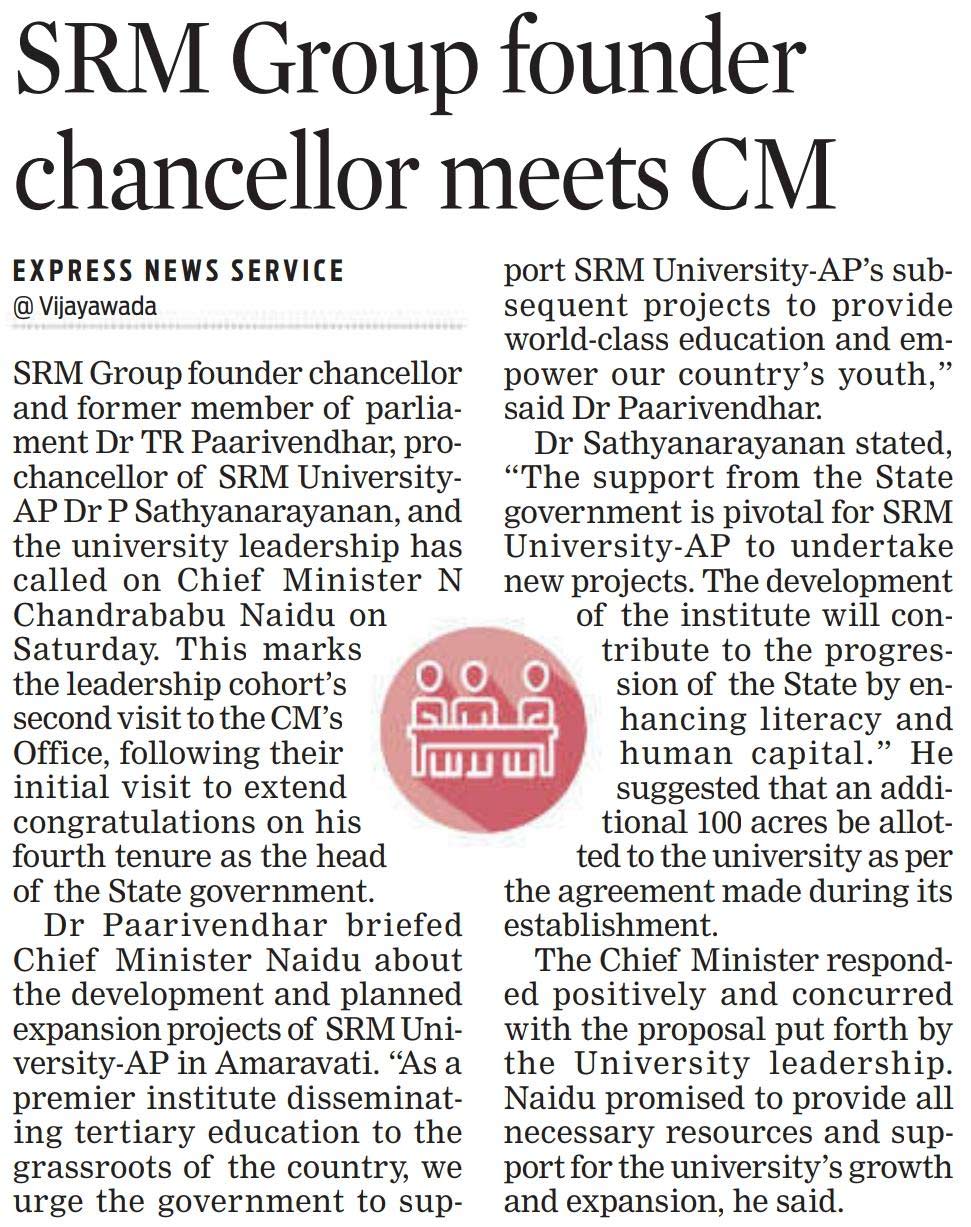
The Pioneer

Vartha
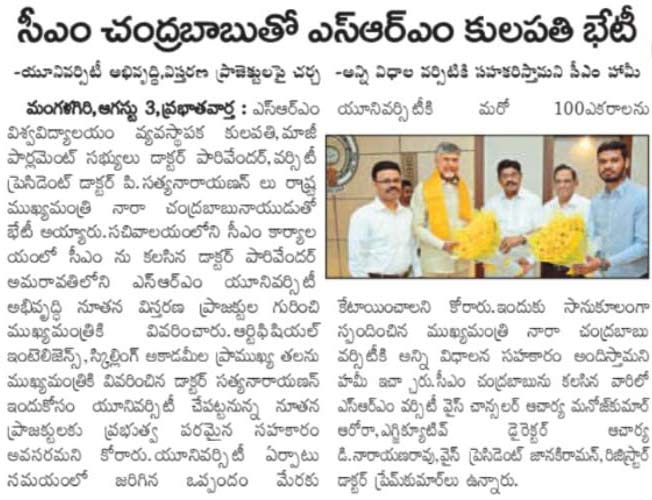
Visalaandhra

Seema Ratnam

Eenadu

Andhra Jyoti
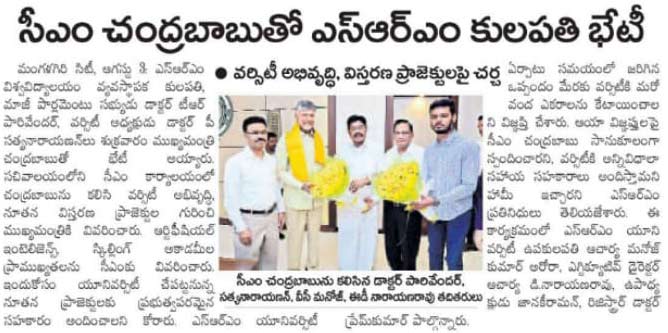
Andhra Patrika
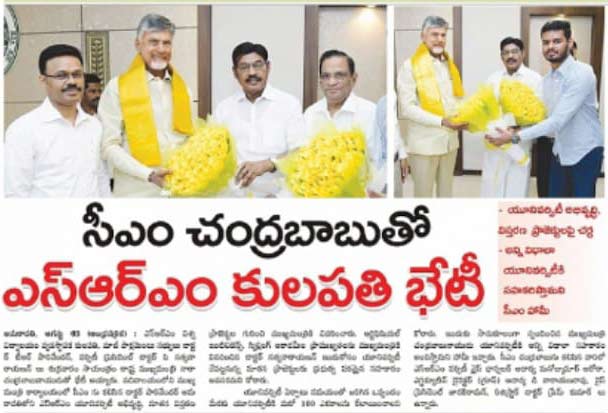
Andhra Prabha
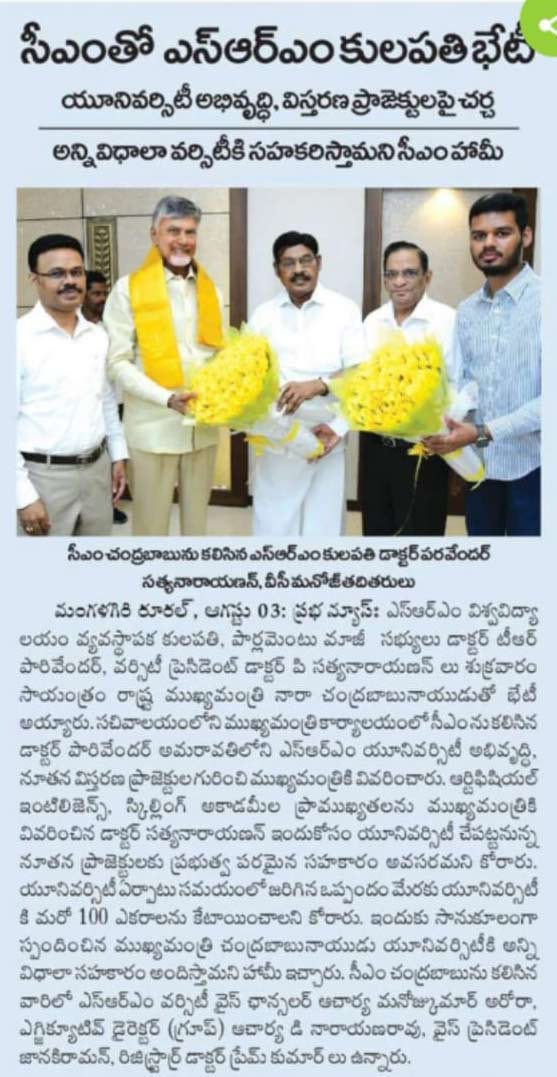
- Founder Chancellor and University Leadership Meet the Honourable CM of AP August 5, 2024

Founder Chancellor of SRM Group and former Member of Parliament Dr T R Paarivendhar and Pro-Chancellor Dr P Sathyanarayanan met the Chief Minister of the state, Shri Nara Chandrababu Naidu, at the Office of the Secretariat. This is the second visit of the university leadership to the Chief Minister’s Office, as the former had first approached the CM to extend their congratulations on his fourth tenure as the head of the state government.
Dr Paarivendhar briefed Chief Minister Shri Naidu about the development and planned expansion projects of SRM University-AP in Amaravati. “As a premier institute disseminating tertiary education to the ground roots of the country, we politely urge the government under the lead of Shri Chandrababu Naidu to cordially aid SRM University-AP’s subsequent projects to provide world-class education and empower our country’s youth”, said Dr Paarivendhar.
Emphasising the importance of educating the youth in emerging fields such as Artificial Intelligence, enhancing 21st-century skills and the significance of an industry-led academic curriculum to the Chief Minister, Dr Sathyanarayanan stated that “The support from the state government is pivotal for the SRM University-AP to undertake new projects. The development of the institute will summate to the progression of the state by enhancing literacy and human capital.” He suggested that an additional 100 acres could be allotted to the university as per the agreement made during the establishment of the university.
Chief Minister Chandrababu Naidu responded positively and concurred with the proposal proffered by the university leadership. Shri Naidu promised to provide all required resources and support towards the university’s growth and expansion.
Vice Chancellor Prof. Manoj K Arora, Executive Director (SRM Group) Prof. D Narayana Rao, and Registrar Dr Premkumar, were also part of the leadership cohort that met the Honourable CM.
Continue reading → - Exploring the Impact of Welding Processes on Duplex Stainless Steel Parts in Additive Manufacturing August 5, 2024
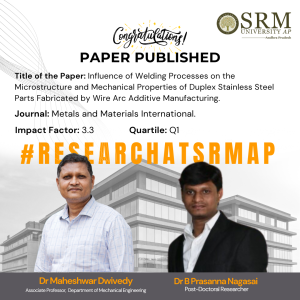 In a recent publication in the prestigious Journal Metals and Materials International, Dr Maheshwar Dwivedy, Associate Professor in the Department of Mechanical Engineering and Dr B Prasanna Nagasai, Post-Doctoral Researcher, delve into the intricate relationship between welding processes and the resulting microstructure and mechanical properties of Duplex Stainless-Steel parts fabricated through Wire Arc Additive Manufacturing.
In a recent publication in the prestigious Journal Metals and Materials International, Dr Maheshwar Dwivedy, Associate Professor in the Department of Mechanical Engineering and Dr B Prasanna Nagasai, Post-Doctoral Researcher, delve into the intricate relationship between welding processes and the resulting microstructure and mechanical properties of Duplex Stainless-Steel parts fabricated through Wire Arc Additive Manufacturing.The research paper, aptly titled “Influence of Welding Processes on the Microstructure and Mechanical Properties of Duplex Stainless-Steel Parts Fabricated by Wire Arc Additive Manufacturing,” illuminates the crucial factors that influence the quality and performance of components produced using this innovative manufacturing technique.
This collaborative effort not only enriches the academic community but also holds promising implications for the advancement of additive manufacturing technologies, particularly in the realm of Duplex Stainless-Steel fabrication. By unravelling the impact of different welding processes on the microstructural characteristics and mechanical behaviour of such components, the researchers offer valuable insights that can potentially enhance the efficiency and reliability of the manufacturing process.
The publication of this paper signifies a significant milestone in the ongoing exploration of material science and additive manufacturing techniques, highlighting the dedication and expertise of Dr Maheshwar Dwivedy and Dr B Prasanna Nagasai in pushing the boundaries of knowledge and innovation in the field.Abstract
Direct energy deposition (DED) is an advanced additive manufacturing (AM) technique for producing large metal components in structural engineering. Its cost-effectiveness and high deposition rates make it suitable for creating substantial and complex parts. However, the mechanical and microstructural properties of these components can be influenced by the varying heat input and repeated thermal treatments associated with different welding procedures used during the deposition process. This study employed gas metal arc welding (GMAW) and cold metal transfer (CMT) arc welding techniques to fabricate cylindrical components from 2209 duplex stainless steel (DSS).
The research investigated the impact of these welding methods on the microstructure and mechanical properties of the 2209 DSS cylinders. The intricate thermal cycles and cooling rates inherent in the DED process significantly influenced the primary phase balance, ideally comprising 50% austenite and 50% ferrite. In components processed using GMAW, σ-phase formation was noted at the grain boundaries. Additionally, a slower cooling rate and extended time for solid-state phase transformations led to an increase in austenite content from the bottom to the top of the component. The cylinder fabricated using the CMT process exhibited fine austenite morphologies and a higher ferrite content compared to the GMW-processed cylinder.
Furthermore, the cylinder produced using the CMT process showed consistent properties across the building direction, unlike the components manufactured with the GMW process. In terms of tensile properties, hardness, and impact toughness, the cylinder produced using the CMT technique outperformed the one made with the GMW process.
Research in Layperson’s Terms
Over the last ten years, a new way of making things called additive manufacturing (AM) has become really popular, especially in industries like aerospace, oil, and gas. This technology builds parts layer by layer, which is a big change from traditional methods that often involve cutting away material to shape a part. One specific method of AM, called Directed Energy Deposition (DED), is particularly good at creating complex metal parts quickly and efficiently. A special kind of stainless steel called duplex stainless steel (DSS) is made of two types of microstructures, ferrite and austenite, which give it great strength and resistance to corrosion. This makes it ideal for use in demanding environments like the oil and gas industry.
A technique within DED called Wire Arc Additive Manufacturing (WAAM) is becoming a popular way to make large, strong metal parts like pipes and storage tanks. WAAM uses the same equipment as welding and can build parts by melting wire with an electric arc. It’s faster and cheaper than other AM methods. However, the process can change the structure of the metal, which affects its properties. For example, too much heat can reduce the amount of ferrite in the metal, making it less strong.
Researchers have been studying how different methods of WAAM, including ones that use less heat, affect the metal’s structure and properties. They’ve found that controlling the heat can lead to better mechanical properties, like higher strength and toughness. They’ve also looked at new technologies like digital twins (virtual models of the manufacturing process) to improve the stability and consistency of the process. In this study, researchers focused on making cylindrical parts from 2209 DSS using two different welding processes within WAAM: Gas Metal Arc Welding (GMAW) and Cold Metal Transfer (CMT).
They studied how these processes affected the metal’s structure and properties, like tensile strength, hardness, and toughness. The goal was to understand which process produces the best quality parts for industrial use. In summary, the research aims to improve the manufacturing of strong, corrosion-resistant metal parts using advanced AM techniques, making them more efficient and cost-effective for industries that need durable components.
Practical Implementation or the Social Implications Associated
The practical implementation of this research can revolutionise industrial manufacturing, especially in sectors like aerospace, oil and gas, automotive, and marine applications. Using WAAM with DSS, industries can produce lightweight, high-strength parts that withstand extreme environments, significantly improving efficiency and cost-effectiveness. WAAM’s ability to quickly produce customized and high-quality components also makes it ideal for rapid prototyping and repair, reducing lead times and overall production costs. Furthermore, WAAM is a more sustainable manufacturing method, generating less waste and utilizing recycled materials, contributing to eco-friendly production practices. The social implications are substantial, including the creation of new job opportunities and the need for specialized training programs to equip workers with advanced skills.
The economic impact is also notable, as WAAM enhances the competitiveness of companies, driving economic growth in high-tech industries. Innovation is fostered through advancements in manufacturing processes and materials science, leading to improved product performance and longevity, particularly in safety-critical applications. Additionally, the environmental benefits of reduced waste and potential use of recycled materials align with global sustainability goals. Overall, the adoption of WAAM can democratize the manufacturing landscape, making advanced technologies more accessible and affordable for smaller companies and startups, thereby fostering a more inclusive and innovative industrial environment.
Future Research Plans:
Continue reading →
The upcoming work will focus on creating Functionally Graded Materials (FGMs) using Wire Arc Additive Manufacturing (WAAM) by merging various metals, including nickel, stainless steel, mild steel, Inconel 718, and AISI 410 MSS. The goal is to optimise material interfaces, refine deposition processes, and ensure structural integrity for high-performance applications. - Unraveling Chaos Dynamics in Cancer: Dr Koyel Chakravarty’s Breakthrough Research August 5, 2024
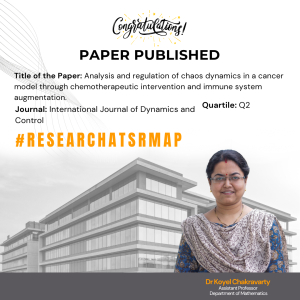 Dr Koyel Chakravarty, Assistant Professor in the Department of Mathematics, has made a significant contribution to the field of cancer research with her paper “Analysis and Regulation of Chaos Dynamics in a Cancer Model through Chemotherapeutic Intervention and Immune System Augmentation,” which was recently published in the International Journal of Dynamics and Control. In her paper, Dr Chakravarty delves into the intricate world of chaos dynamics within a cancer model and explores the potential for regulating these dynamics through the combined approach of chemotherapeutic intervention and immune system augmentation.
Dr Koyel Chakravarty, Assistant Professor in the Department of Mathematics, has made a significant contribution to the field of cancer research with her paper “Analysis and Regulation of Chaos Dynamics in a Cancer Model through Chemotherapeutic Intervention and Immune System Augmentation,” which was recently published in the International Journal of Dynamics and Control. In her paper, Dr Chakravarty delves into the intricate world of chaos dynamics within a cancer model and explores the potential for regulating these dynamics through the combined approach of chemotherapeutic intervention and immune system augmentation.Her research offers insights into understanding the complex behaviour of cancer cells and how such insights can be leveraged to develop more effective treatment strategies. Dr Chakravarty’s work marks a crucial step forward in the ongoing efforts to combat cancer, shedding light on the dynamic interplay between therapeutic interventions and the body’s immune response.
The publication of this paper not only underscores Dr Koyel’s expertise in the field of mathematical analysis in cancer research but also signifies a promising advancement in the collective pursuit of understanding and addressing the challenges posed by cancer.
Abstract
The focus of the current investigation lies in the formulation and analysis of a dynamic model depicting cancer growth, incorporating the joint influences of chemotherapy and immune system augmentation. The primary emphasis of this study revolves around the analysis of the dynamic behaviour within a living-cell closed carcinoma system, specifically one devoid of external vitamin support, with a particular exploration of chaos dynamics. Subsequently, the authors aim to scrutinise the pivotal impact of infused vitamins in attaining stable system dynamics through the application of chaos control techniques.
The formulated model exhibits fundamental mathematical properties, revealing a spectrum of co-dimension one and co-dimension two bifurcations. The identification of specific bifurcation types relies on algebraic criteria techniques, where conditions necessary and sufficient for bifurcation types are developed. Notably, these criteria are distinct from traditional approaches based on the characteristics of the eigenvalues of the Jacobian matrix, instead relying on coefficients derived from characteristic equations. The accuracy of the analytical conclusions is validated through numerical findings, elucidating diverse bifurcation structures. The article enriches its contribution by delving into the control of chaos through the reinforcement of the internal immune system and the maintenance of the biological system’s stability. This work culminates in proposing future directions aimed at advancing a more realistic approach to eradicating cancer.
Research in Layperson’s Terms
This study focuses on developing and analysing a model that simulates how cancer grows, considering both chemotherapy and the immune system’s response. The main goal is to understand how cancer behaves over time in a system that doesn’t have external vitamin support, especially looking at how chaotic or unpredictable the growth can become. The researchers also investigate how adding vitamins might help stabilise this chaotic system using specific control techniques. The model they created has certain mathematical features that show different types of changes, called bifurcations, which can occur under specific conditions.
Additionally, the study explores how strengthening the immune system might help control this chaos and stabilise the biological system. The paper concludes by suggesting future research directions that could lead to more effective cancer treatment strategies.Practical implementation
The practical implementation and social implications of analysing and regulating chaos dynamics in a cancer model through chemotherapeutic intervention and immune system augmentation can be profound. Insights gained from this research could be applied to optimize cancer treatment protocols, potentially leading to more effective therapies with reduced side effects. By understanding and controlling the chaotic behaviour in cancer systems, patient outcomes could be improved through personalized treatment strategies.
Socially, the adoption of these findings may lead to increased public confidence in advanced cancer treatments, as well as a broader acceptance of integrating immune system support with traditional therapies. The potential for more stable and predictable treatment outcomes may also reduce the emotional and financial burden on patients and healthcare systems. Additionally, this approach may encourage further interdisciplinary research, bridging gaps between Mathematics, Biology, and Medicine, thus fostering innovation in cancer therapy development.Collaborations
Dr Lakshmi Narayan Guin, Associate Professor, Department of Mathematics, Siksha Bhavana, Visva-BharatiFuture research plans
Potential areas for further exploration include:- Personalised Medicine: Developing patient-specific models that consider individual biological variations could lead to more tailored and effective cancer treatments, minimising side effects and improving outcomes.
- Integration with Advanced Therapies: Combining the insights from chaos dynamics with emerging therapies such as immunotherapy, targeted therapy, and gene editing could enhance the precision and efficacy of cancer treatments.


